January 26th, 2017 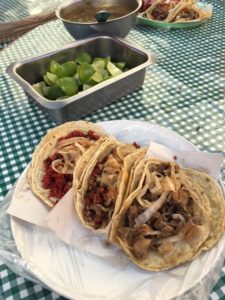 Coming to Mexico, I knew there would be delicious tacos aplenty. Those certainly didn’t disappoint. Every taco I’ve eaten has been tasty, from the ones sold in street carts outside our office to the ones you can buy from guys who ride around the city on bikes ringing a bell to let you know they have tacos (sadly, this is not where Taco Bell got its name, but I like to pretend). Coming to Mexico, I knew there would be delicious tacos aplenty. Those certainly didn’t disappoint. Every taco I’ve eaten has been tasty, from the ones sold in street carts outside our office to the ones you can buy from guys who ride around the city on bikes ringing a bell to let you know they have tacos (sadly, this is not where Taco Bell got its name, but I like to pretend).
Most of the street tacos run somewhere from 10-50 cents apiece. A local explained to me that “you can tell the best taco places by the size of the meat roasting out front,” because the taco stands with the largest hunks of meat over the grill were expecting the
most customers. On the other hand, if you prefer fancy tacos, you can try them at local restaurant chains like El Califa, which will run you more like $1.50-3 each (I know, gasp).
There’s also chilaquiles of course. The best I found were  right next to my apartment at Café el Asturiano, a hole-in-the-wall with a 70 peso ($3.50) breakfast menu that includes red or green chilaquiles (get the green), fresh fruit, fresh-squeezed juice, fresh-baked bread and a tea or coffee. right next to my apartment at Café el Asturiano, a hole-in-the-wall with a 70 peso ($3.50) breakfast menu that includes red or green chilaquiles (get the green), fresh fruit, fresh-squeezed juice, fresh-baked bread and a tea or coffee.
What I did not expect was the rest of the food. The weird-but-worth-trying Mexican sushi at Moshi-Moshi (most of the rolls include cheese, mango or both); the salads, acai bowls and duck pate sandwiches so rich you have to eat them with a glove at Corredor Salamana, an open-air cafeteria-style restaurant/bar/cafe/ping-pong/hookah lounge where we wound up more nights than we ought to admit.
 Crepes stuffed with ricotta and covered in berries at Crepes y Waffles I ate the best ceviche I’ve ever tried and followed it up with a rich, spicy hot chocolate at Mercado Roma; sampled crepes and waffles at the aptly named Crepes y Waffles; fell in love with pozole, a rich stew-like soup, at La Casa de Toño (great hangover cure, by the way).
 The Mexico City restaurant scene rivals New York’s, in my amateur-foodie opinion. There are fantastic seafood restaurants like Contramar; up-and-coming vegan delivery spots like Los Loosers, which changes its menu daily (it was mole ramen the day I went); and three of the top 50 restaurants in the world. A lot of the people I’m traveling with raved about Biko and Quintonil, two of those, but I only tried Pujol. It was a uniquely delicious experience, and I loved everything from the baby corn cooked in chicatana ant sauce to the mole madre (which had been cooking for 1,185 days when we went). The humorously-named Happy Ending was delicious too—a dessert course comprised of avocado ice cream, churros, coconut pastry, and some kind of chocolate-y beverage. If the other two top restaurants are anything like Pujol, holy crap, I need to come back to Mexico City ASAP and eat there too. The Mexico City restaurant scene rivals New York’s, in my amateur-foodie opinion. There are fantastic seafood restaurants like Contramar; up-and-coming vegan delivery spots like Los Loosers, which changes its menu daily (it was mole ramen the day I went); and three of the top 50 restaurants in the world. A lot of the people I’m traveling with raved about Biko and Quintonil, two of those, but I only tried Pujol. It was a uniquely delicious experience, and I loved everything from the baby corn cooked in chicatana ant sauce to the mole madre (which had been cooking for 1,185 days when we went). The humorously-named Happy Ending was delicious too—a dessert course comprised of avocado ice cream, churros, coconut pastry, and some kind of chocolate-y beverage. If the other two top restaurants are anything like Pujol, holy crap, I need to come back to Mexico City ASAP and eat there too.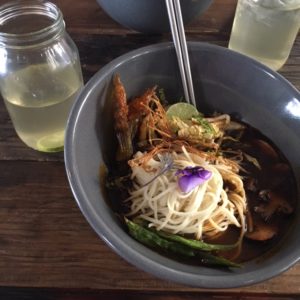
My trip wasn’t all fine-dining though. There was the mysterious torta I bought from a guy with a bucket of sandwiches on a bus to Angangueo (definitely an interesting experience, but not recommended), and the street flautas which were delicious but difficult to eat, considering the only utensil the cart vendor gave me was a spoon. We cooked a traditional Carne Asada on the rooftop of my local Spanish teacher’s apartment, and then I got sick (probably from too much red meat in one day). One night we had the brilliant idea to go to a rooftop bar for the scenic view and supposedly famous burgers. Unfortunately, not only was it freezing that night, but we also waited two and a half hours for an extremely rare (read: still frozen inside) burger.But overall, the less-than-savory (haha see what I did there) experiences were anomalies, far outweighed by the delicious ones. For example, I ate the best Caesar salad I’ve ever tasted in an airport sports bar while awaiting a flight to Cuba—the waiter hand-mixed the sauce right at our table, complete with fresh anchovies.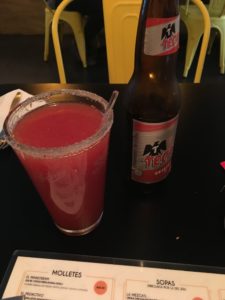
And of course, I can’t rave about the food without mentioning the drinks, too.
Between the clamatos (the beer-based version of a Bloody Mary) at Juan Molletes; the micheladas and cubanas (beer mixed with lime juice and Worcestershire sauce respectively) at La Cervecería del Barrio; the gin-and-rose cocktails at Gin Gin; and every type of mezcal you could ask for (either neat or mixed into perfectly-balanced cucumber and avocado cocktails) at La Clandestina, a speakeasy in the back of La Lavandería in Condesa, Mexico City’s mixology scene is at the top of its game too.
Not to mention you can get a nice bottle of Chilean wine at just about any corner store for ~$5, which is hard to beat back home.
All in all, I will definitely be back here for the food alone. I’m already sad to be leaving so soon, when there are still so many restaurants, bars and street carts I need to explore… Though I’m excited to move along to Colombia next month and try out the food scene there, too!
Whatever you do, though, the next time you’re in Mexico City, remember one thing. The tacos are great, the clamatos and micheladas are tasty, but…
You need to try the crickets.
(Trust me, they’re a whole lot tastier than they look…)
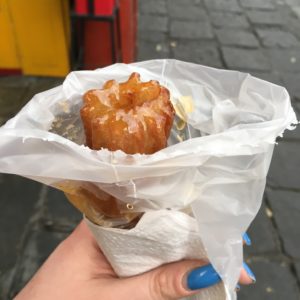 Street churros in Coyoacán 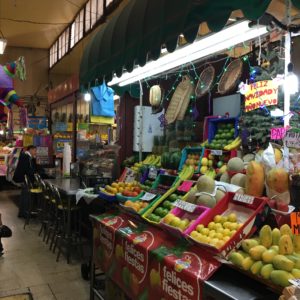 The market in Coyoacán 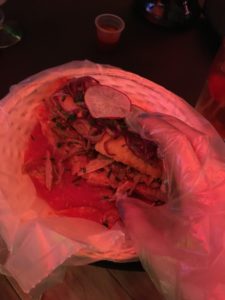 Torta de pato (duck) so mess it requires a glove to eat 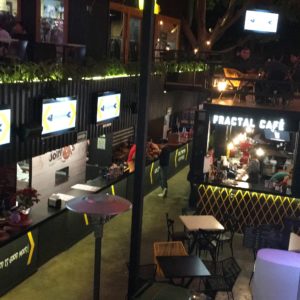 Corredor Salamana, which we affectionately named Fractal for the excellent coffee shop on the ground floor 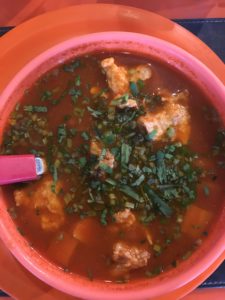 Sopa de pescado at the Mercado Roma  Street vendors near our office  Mole with eggs and Spanish rice at Casa de las Sirenas downtown 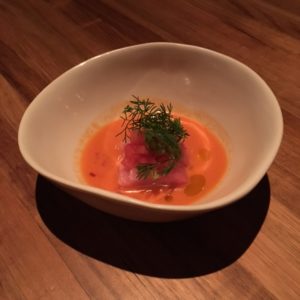 Crudo course at Pujol: raw tuna in a vinaigrette 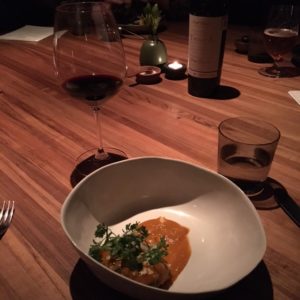 Amarillito tamales (vegetable) at Pujol  Mole madre (1185 days) at Pujol 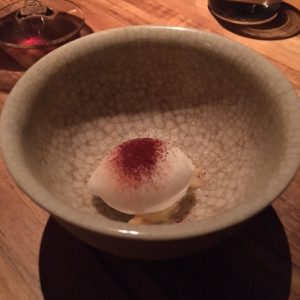 Palate cleansing course at Pujol (yes, it’s sorbet)  Happy Ending: the dessert course at Pujol 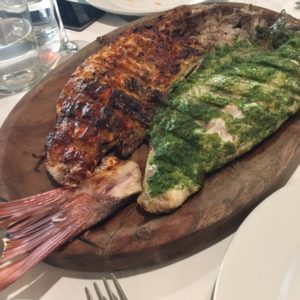 Whole fish at Contramar
January 23rd, 2017 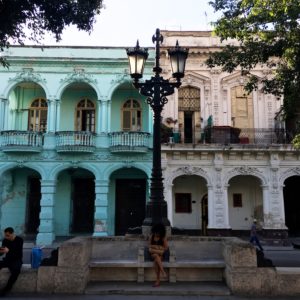 Habana Vieja (Old Havana) Last weekend, I went on my first side-trip to Cuba for the long weekend. It wound up being a great trip by the end, but there was a steep learning curve, so I figured I’d share how not to plan your trip (learn from my mistakes!).
1. Don’t forget your cash.
Luckily I planned ahead for this part, at least. US debit and credit cards don’t work in Cuba, so Americans need to bring as much cash as they’ll need for their entire trip. I budgeted $100 a day, and wound up with $5 left at the airport (which I spent on the world’s strangest steak sandwich), so that seemed about perfect.
2. If you’re staying in Havana, don’t book a place far from city center.
Trust me. GPS is not a thing there. Neither are cell phones or maps. If the taxis can’t find your Airbnb, you’ll spend half your trip giving directions and the other half winding up lost at 3am.
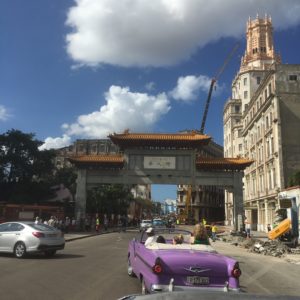 Vintage car tour through el Barrio Chino (Chinatown) 3. Don’t rely on finding internet.
Seriously, it doesn’t exist. Pretend it’s 1990 and plan everything you want to do (and where/when you’ll rendezvous with your friends) ahead of time. If you absolutely must find internet, the Hotel Nacionale (worth a visit on its own for the beautiful architecture and the cash exchange in its basement if you need it) has Wifi you can access for $10/hour, but it is still a very weak signal.
4. Don’t use your cell phone.
I made the mistake of turning on data a couple times to locate friends. $65 in roaming charges later… Ouch.
5. Don’t plan too much in one day.
Life moves slower in Cuba. Glacially slow. It can be a really fun, relaxing getaway if you’re prepared for that, but if you’re expecting to run around and see a zillion things every day, then you will get frustrated. (It was so difficult to silence my inner New Yorker this trip.)
 Habana Vieja 6. Don’t be freaked out by the way things appear.
We all know Havana is stuck in the 1950s. But from afar, that can sound romantic and nostalgic. In reality, it means that some houses look like ruins. Ceilings have fallen in, doors are missing, everything is broken and peeling. Same goes for the cars. On the surface, it can look dangerous. But Havana is probably one of the safest places you’ll ever visit, despite its appearances.
7. Don’t expect good food.
The pizza tastes like a disassembled hot pocket. The tuna is all canned. There’s meat in just about everything, and your salad will most likely not be fresh. There are good restaurants here and there (I highly recommend La Catedral and Decamarón, both in Vedado), but remember, Cuba has been on food rations for decades. Of course the restaurants have struggled. Which leads me to my last point…
8. Don’t forget where you are.
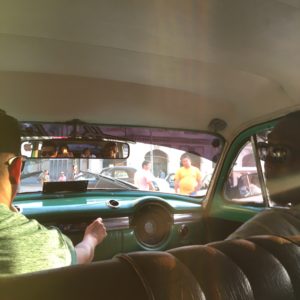 Navigating the taxis in Habana Vieja As an American visiting Cuba, I became intensely aware of my own privilege. I can travel almost anywhere in the world, whenever I want to, simply because I was born in the USA. Most Cubans (especially any doctors or skilled professionals) are not allowed to leave their country, even for a vacation. They live in the houses the government decided their families would have, drive falling-apart “vintage” cars because our government decided they couldn’t import new ones…
It’s intense. It’s eye-opening. It’s the first time in a long time that I experienced culture shock, and it really woke me up.
But this list sounds very negative. I’m not saying you shouldn’t go to Cuba. By the end of my visit, I really loved it. It was a unique experience, and I learned a ton.
So, now that we’ve covered what not to do, what should you do?
 Tropico beach in Playas del Este 1. Relax and go with the flow.
Sneak up to the rooftop bar at Hotel Saratoga. Kick off your shoes, stick your feet in the pool, and spend a while admiring the view.
Explore Old Havana. Buy some cigars or enjoy a cuba libre (rum and coke) in one of the bars that dot the neighborhood.
Visit the Playas del Este, the beaches east of Havana. There’s a number of them, though we found Tropico pretty uncrowded (also, the snack huts dotting the beach serve epic piña coladas).
 Sunset over the Malecón Walk along the Malecón (the seawall bordering the city) and get soaked by waves while you drink in the sunset.
While you’re on the Malecón, go dancing at the seaside salsa club 1830. I guarantee you’ll feel like you’re at someone’s backyard BBQ, sharing drinks and getting swung across the dance floor by locals. If it’s rainy, though, you can always dance indoors at Casa de la Musica Miramar instead, or even catch a show. We watched Pupy perform live, after having a couple of drinks next door at the cafe attached.
But the biggest lesson I learned was just to go with the flow. Pre-planning is nice, but if you plan your day to death, you’ll spend most of it working on frustrating logistics (like trying and failing to rendezvous with the vintage car tour you booked), rather than actually experiencing Havana.
2. Talk to locals.
There’s no better way to get to know a city—or to find your new favorite night out spot! Our Airbnb hostess Julia was extremely sweet and helpful, always recommending new spots for us to check out (if you decide on an Airbnb in Cuba, definitely check out House Blue Sea).
3. Brush up on your Spanish (and bring/download a really good dictionary).
 Vedado neighborhood Some people speak English, but many don’t. It was helpful to know the essentials, especially when talking to taxis, ordering in restaurants, or going out dancing in the clubs. Also, without internet or cell phone access, looking up translations on the fly gets tricky, so either bring a pocket dictionary with you, or download an app like Google Translate, which allows you to download language packs for offline use in advance.
4. Be present.
Havana is a strange, beautiful, wistful, inspiring place to visit. It forces you to disconnect—from modernity, from the world you’re used to, from the internet (I know I keep saying this but it’s only because I have a serious ‘net addiction, okay?). It can be jarring at first, and it can throw you out of your element. But that’s the beauty of it.
Just let yourself live in the moment and experience what’s in front of you. Don’t worry that you’re missing out on a million other things (it’s impossible to see it all anyway).
Simply enjoy where you are.
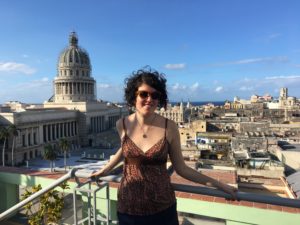 View from Hotel Saratoga’s rooftop 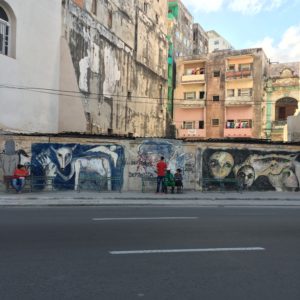 Street art in Habana Vieja 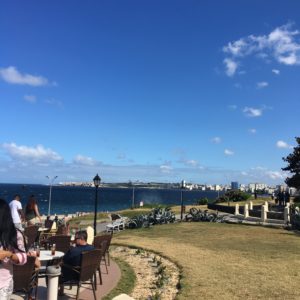 View from the Hotel Nacionale  Caipirinha at Hotel Saratoga
January 17th, 2017  Trying to speak Spanish after 10 years without using it is a constant exercise in humility. One moment I’m having an in-depth conversation with a doctor about switching medications from my U.S. brand to a comparable Mexican one, and the next minute I’ve completely forgotten the word for fork. Trying to speak Spanish after 10 years without using it is a constant exercise in humility. One moment I’m having an in-depth conversation with a doctor about switching medications from my U.S. brand to a comparable Mexican one, and the next minute I’ve completely forgotten the word for fork.
But as the month progresses, I realize my Spanish isn’t the only thing that’s out-of-practice. I’ve forgotten how to learn.
 It’s not that I don’t enjoy learning. I love reading books, going on historical tours, watching documentaries. But I’m bad at it, because I make everything about me. When a tour guide talks about local history, I usually latch on to the first interesting tidbit they mention, then drift off into daydreams—thinking about how I could use that factoid in a story, or how it intersects with other facts I’ve heard. It’s not that I don’t enjoy learning. I love reading books, going on historical tours, watching documentaries. But I’m bad at it, because I make everything about me. When a tour guide talks about local history, I usually latch on to the first interesting tidbit they mention, then drift off into daydreams—thinking about how I could use that factoid in a story, or how it intersects with other facts I’ve heard.
I stop listening.
And sure, I remember that particular tidbit very well. I file it away in long-term memory and I trot it out whenever someone mentions they’re about to visit  that place or go on that tour. Usually it’s even interesting (or at least, I think so). that place or go on that tour. Usually it’s even interesting (or at least, I think so).
But I’m missing the point. I’ve focused on one aspect of the story instead of absorbing the whole narrative. I’m trying to see everything through my own lens.
Technically, it’s impossible to experience anyone else’s world. We can only rely on our own perceptions, experiences, lifetimes. But just because it’s impossible doesn’t mean we shouldn’t try. Understanding is the building block of empathy, compassion, expansion.
Why am I traveling around the world if I think I already know everything about it?
So I’m trying to quiet that inner voice, to listen instead of waiting for my turn to speak. 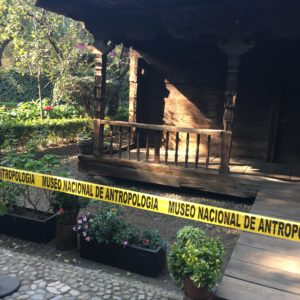
I visited the Museo Nacional de Antropología and practiced my Spanish by reading about the ancient city of Teotihuacan, the first true metropolis in North America. I learned about the Toltec political system and the rise of the Aztecs. I learned that Nahuatl (the language of the Aztecs) is still spoken today, and moreover, how much it influences place names, food names, slang and other words in Spanish and even English (we have them to thank for “avocado”).
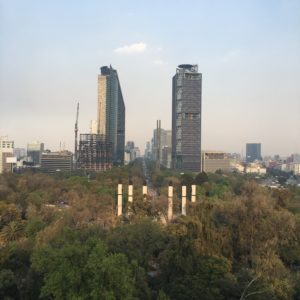 Across the Bosque de Chapultepec (Chapultepec Park), I climbed up to Chapultepec Castle for the best view of Mexico City that I’ve yet to find—and to read up a bit more on the Spanish conquest and local governments before and after. Across the Bosque de Chapultepec (Chapultepec Park), I climbed up to Chapultepec Castle for the best view of Mexico City that I’ve yet to find—and to read up a bit more on the Spanish conquest and local governments before and after.
I went on a free walking tour around Coyoacán, a neighborhood I knew nothing about. It used to be a separate island, and still maintains its own distinct history, flavor, culture.
In the Mercado de Coyoacán, I ate dried crickets and churros (more on all the delicious food there next week). I experienced my first Lucha Libre event in the
 Arena México and learned that hechicero means sorcerer. I met up with an old college friend and an internet friend who also works remote, whose schedule finally synced with mine (after 10 years of trying). I visited Paseo Interlomas, a Mexican mall that includes, among other things, an ice skating rink, a surprisingly pretty outdoor garden overlooking the city, and a restaurant with air hockey tables (which was sadly closed). Arena México and learned that hechicero means sorcerer. I met up with an old college friend and an internet friend who also works remote, whose schedule finally synced with mine (after 10 years of trying). I visited Paseo Interlomas, a Mexican mall that includes, among other things, an ice skating rink, a surprisingly pretty outdoor garden overlooking the city, and a restaurant with air hockey tables (which was sadly closed).
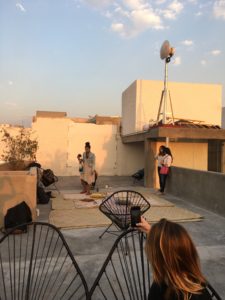 Along with a few other Remotes, I watched the Chef’s Table episode about Pujol, one of the best restaurants in the world, and got really excited for my reservation there (next Wednesday!). I visited the beautiful Casa de Cultura—Jesús Reyes Heroles and fell in love with the gardens (perfect spot to read a book or journal for an hour or two). I walked past Frida Kahlo’s Blue House—and learned that I’ll definitely need to book ahead if I want to go inside. Along with a few other Remotes, I watched the Chef’s Table episode about Pujol, one of the best restaurants in the world, and got really excited for my reservation there (next Wednesday!). I visited the beautiful Casa de Cultura—Jesús Reyes Heroles and fell in love with the gardens (perfect spot to read a book or journal for an hour or two). I walked past Frida Kahlo’s Blue House—and learned that I’ll definitely need to book ahead if I want to go inside.
It’s been a week of new experiences, new sights and sounds and food. And that’s before my weekend in Cuba (talk about culture shock). I’m trying my best to take it all in.
 Coyoacán houses are colorful and brightly decorated, usually with a ton of plants out front 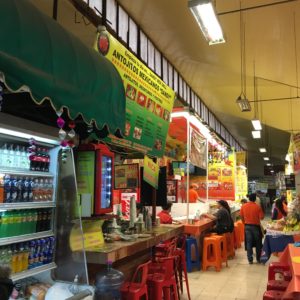 Mercado de Coyoacán (try the crickets—seriously!)  Street Saint in Coyoacán (a common feature on the street corners in that neighborhood) 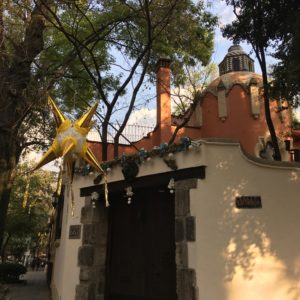 Christmas Piñatas (distinguishable from normal piñatas by the star design—the pointed cones originally represented the 7 deadly sins)  Coyoacán smelled like flowers the entire tour—this might be why
January 10th, 2017 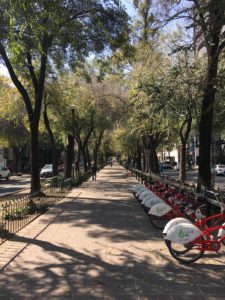 I haven’t been at the freelance bit long (just over 2 weeks full-time), but I am already starting to notice things I’ll miss about working a regular 9-5 office job. Nothing earth-shattering, just little day-to-day amenities that I took for granted when they were right in front of me. Now that I’m out of the office and striking forth on my own, I’ve started to notice those little things. I haven’t been at the freelance bit long (just over 2 weeks full-time), but I am already starting to notice things I’ll miss about working a regular 9-5 office job. Nothing earth-shattering, just little day-to-day amenities that I took for granted when they were right in front of me. Now that I’m out of the office and striking forth on my own, I’ve started to notice those little things.
In case anyone else reading here is debating going freelance (or maybe already has!), I’ve put together a top 10 list.
10 Things I Miss About My Office:
- Copiers/printers/scanners. (Traveling with a printer is impossible, and you’d be surprised how quickly those little per-page fees add up. Not to mention the lack of multi-page scanners at most printing places… ugh!)
- Office supplies. (Where do all the pens go?! The same place missing socks vanish to?)
- Healthcare. (Though healthcare/travel coverage outside the U.S. from U.S.-based providers is surprisingly affordable)
- Mail room. (Not that I send snail mail often, but it’s nice to just be able to drop large boxes off in an outgoing mail tray…)
- Coworkers. (Okay, that’s the obvious one)
- A desk. (It’s handy to be able to leave your computer at work once in a while)
- IT support. (When you’re freelance, it’s up to you to fix that weird website bug!)
- Team happy hours/lunches. (Nothing beats the camaraderie of a team that’s all dealing with the same problem.)
- Free tea/coffee. (For budgetary/addiction reasons.)
- Leftover lunches from noon meetings. (Don’t judge me, you know we all turn into vultures around free food.)
But if that sounds dire to anybody, don’t worry, I’m not pining for home or tempted to run back to my desk. I’ve actually got a pretty great counter-list so far, after freelancing full-time for the last couple of weeks.
5 Best Things About Freelancing
- The hours. (Tired from a long exciting weekend? Sleep in on Monday! Who cares?)
- The work. (Not gonna lie, I love what I do. I make up stories for a living. Doesn’t get much better than that!)
- The freedom. (I am currently writing this from Mexico City, my first stop on a yearlong round-the-world tour, living in a different city every month. Hard to beat that.)
- The people. (I miss my Wiley fam, but I’ve met a lot of other freelancers doing awesome things this month! It’s fun to hear about new people’s projects and unique work lives.)
- The work. (Did I mention I make stuff up for a living?)
So for all the comfort and security of my day job that I’ll miss, I can’t say I’m regretting my decision.  Weirdly, I’ve been waking up earlier than I used to for my office hours – I’m that excited to hop out of bed and start writing every day! All things considered, I made the right call going freelance. (At least, so I think after a few weeks. We’ll see how I’m feeling in a year!) Weirdly, I’ve been waking up earlier than I used to for my office hours – I’m that excited to hop out of bed and start writing every day! All things considered, I made the right call going freelance. (At least, so I think after a few weeks. We’ll see how I’m feeling in a year!)
But if I needed any further confirmation, I got it when I parked myself in a bookstore here in Mexico City. I found this store in the Bosque de Chapultepec (a park near the apartment I’m renting this month), and wound up lingering in it for a few hours, writing and taking notes on future projects.
The view of the paddleboats on the lake outside, and the great selection of English and Spanish books made it difficult to leave. I definitely didn’t have an experience like that in my old office!
But hey, the freelance life isn’t for everybody, and I’m starting to understand why. There are lots of minor inconveniences. Personally, I’m just happy that it’s right for me.
January 6th, 2017 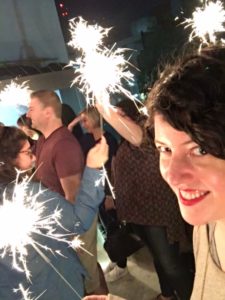 I didn’t make a New Years Resolution so much as a life goal. Last year was great for my writing career, but it turned me into a workaholic. I didn’t make a New Years Resolution so much as a life goal. Last year was great for my writing career, but it turned me into a workaholic.
My 2017 goal is Balance.
I plan to concentrate on different aspects of that in each city I visit. In January, which I’m spending here in the beautiful Ciudad de México, I decided to work on slowing down – taking time each day to appreciate where I am and live in the now.
That turned out to be a fitting choice.
From the cafe my new RY roomie and I wandered into on day 1 (a local hole-in-the-wall where we ate chilaquiles, fresh papaya and a mystery breakfast of the day) to the outdoor ping pong bar and food court (a trendy smorgasbord of acai bowls, sushi, tacos and chiles rellenos that would be right at home in Williamsburg), meals here are an experience.
 Much like in Europe, table service is slow, unhurried. Nobody wants to rush you, and nobody is in a hurry themselves, either. The New Yorker in me got impatient at first – I have so much writing to do! So many neighborhoods to explore and museums to visit! Much like in Europe, table service is slow, unhurried. Nobody wants to rush you, and nobody is in a hurry themselves, either. The New Yorker in me got impatient at first – I have so much writing to do! So many neighborhoods to explore and museums to visit!
But then I reminded myself of this month’s focus: Slow Down. Sit back, relax. Enjoy the great food and the even better conversation. I have a whole month here. No need to run around like crazy trying to see it all today.
Yesterday, I went for a stroll through el Bosque de Chapultepec, a park near our workspace. I explored the botanical garden inside, then stared at a map, overwhelmed. Should I visit the Museum of Anthropology, located within the park? The Modern Art Museum is also here. Or I could go into Chapultepec Castle, which looms over the whole forest and houses the National Museum of History.
 I wanted to see them all. But instead of trying to rush, I followed my instincts. I was craving greenery. Instead of museum-hopping, I settled near a stream, took off my shoes, and wrote freehand. Nothing for work, just notes for future stories. Random ideas. Snippets of memories from the week. I wanted to see them all. But instead of trying to rush, I followed my instincts. I was craving greenery. Instead of museum-hopping, I settled near a stream, took off my shoes, and wrote freehand. Nothing for work, just notes for future stories. Random ideas. Snippets of memories from the week.
A local stopped to ask what I was writing. That turned into an hour-long conversation about my trip, the gas riots downtown, his military career and rebound from an accident that nearly paralyzed him.
My Spanish is still rusty. I forgot how to say “lucky” (suerte, by the way) and floundered, trying to describe it for an embarrassingly long time (just try to describe what luck means without using the word itself, I dare you). But like all of the locals I’ve met here so far, he was patient.
He taught me some slang (“padre” means cool – I guess dads are finally cool now!), and gave me trip advice (the Basilica of Guadalupe  is a must see, but not on the 12th of the month, her day, because it’s a madhouse). All throughout our conversation, he kept using the word relajado. To describe life in Mexico City, his job, relationships, people here on the whole. is a must see, but not on the 12th of the month, her day, because it’s a madhouse). All throughout our conversation, he kept using the word relajado. To describe life in Mexico City, his job, relationships, people here on the whole.
“We know how to enjoy life with what we have,” he said (in my approximate translation). “We throw a lot of parties, we don’t work too hard. We remember to live where we are.”
So I adopted that as my word of the week:
Relajado (adj.) – calm, tranquil, relaxed. e.g.: “Este bosque me parece muy relajado.” (This forest seems very relaxing to me.)
Judging by week 1, I picked the perfect place to start living a more balanced 2017.
(By the way, if you want to see more pictures from my trip so far, I’m posting more than you could ever want on Instagram, ha.)
December 26th, 2016 Seven years and two months ago, I moved onto my childhood best friend’s couch on Wall Street with a single suitcase in tow and a publishing job waiting for me.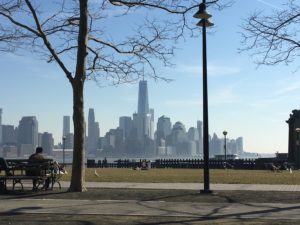
Seven years and two months later, I’ve handed in my notice at that same job and rented out my room in the Astoria apartment I shared with that same friend. I moved back onto her couch with a single suitcase and a very different career on the horizon.
I did not expect to stay this long. My friends can attest that I’ve spent every year here swearing I’d be moving abroad “any day now.”
I did not expect to stay at my first job out of college for 7 years. Nor I did expect to make so many new friends in New York. I think of myself as shy and kind of awkward, so where did all these people who like hanging out with me come from?
I did not expect to grow roots, but apparently I did. I didn’t even notice how deep they ran until it came time to dig them up.
I stayed this long because of the people. I stayed for my childhood and college besties, for the new friends I met at work and at publishing parties, in new-to-the-area meetups and comic conventions.
Last week, I stood in my friend’s tea house (closed for my going away), surrounded by people from all my different New York social groups meshed together. The room felt like a kaleidoscope of all the lives I’ve lived here. The people I’ve known for decades, the ones I’ve only just met, and everybody else in between.
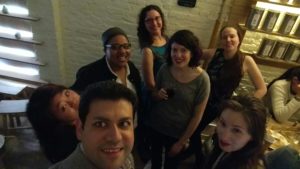
I’m leaving them all.
It hadn’t felt real yet, not until that night. Not until I had to say goodbye.
I’m excited for the next chapter. I can’t wait to explore new cities and make new friends in unexpected places. But leaving is bittersweet. I’ll miss everyone I love in New York, and I’ll miss the city that brought us all together, too.
New York is a city of transplants (with a few proud locals mixed in). It’s a city where your friends become your family, where nobody bats an eye at unusual living situations or the hijinks you get up to on a late-night subway train. You get no privacy here, but neither does anyone else, so we understand when you need to do your makeup in a cab or haul a dog carrier full of doves across town to bird-sit for a weekend.
It’s a city full of artists and writers, actors and dancers. I have a theory that they flock here for the stories. Where else can you find comedic inspiration like a mailman pushing your roommate through a window, or overhearing a drunk guy carry on a 10 minute conversation with your cat? There’s a reason so many sit-coms are set here. People called Unbreakable Kimmy Schmidt “unrealistically weird,” but I noticed the only reviews saying that were written by people who had never lived in NYC.
So, I came for a job. I stayed for the people. But I also fell in love with New York along the way. It feels like home right now, a home I’m leaving behind for I-don’t-know-how-long. And just like the other cities I’ve called home, a piece of me will remain here, no matter where I end up next.
December 6th, 2016 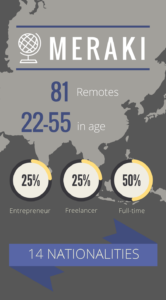 In my last post, I talked about my plan to go freelance in 2017. That’s related to another big life change, which freelancing will enable me to tackle: I’m traveling around the world. In my last post, I talked about my plan to go freelance in 2017. That’s related to another big life change, which freelancing will enable me to tackle: I’m traveling around the world.
On January 1st, I leave New York City for Mexico City. From there, I will spend each month of 2017 in a different country, traveling with a company called Remote Year. I joined their Meraki group, which means that along with 80 other globetrotters, I’ll be following this itinerary.
Living abroad has been a lifelong dream. I got a small taste of it when I studied abroad in Barcelona in college, and again after graduation when I lived in the UK for a summer. But a couple of months didn’t feel long enough to really appreciate life outside the US. And while I’ve traveled extensively since college, I’ve mostly stuck to Europe and North America.
This summer, I started to research the best countries for US expats. I came up with a few viable options (Argentina and Thailand looked pretty appealing), but I was nervous.
How would I find a community?
Was I willing to move to a new country alone, with no one to advise me on local culture or housing or the best places to explore and the spots to avoid?
Would my rusty Spanish improve enough to make friends if I moved to Argentina? Would I be able to study Thai fast enough to communicate?
Then I stumbled across an article about Remote Year. If you’re accepted to a program, for $2,000 a month (plus a down-payment), Remote Year organizes housing, an office/coworking space rental, and travel to and from the countries on their itinerary. Sure, I could find housing and flights to a lot of these places for less, but it would mean intensive research on my part (especially when looking for safe yet reasonable neighborhoods).
But the biggest draw to RY was the community. The people in each RY group run the gamut from freelancers to startup creators to employees at traditional companies. The only thing everyone has in common is the ability to work remotely (at least for one year).
RY is designed to foster a global professional network. In this day and age, as the world shrinks and the internet increases our ability to build communities from oceans apart, that’s the kind of network that makes sense. After all, I have friends dotted across the globe who are just as close to me as my local friends. Why shouldn’t my professional network mirror my personal one?
I’m looking forward to taking this journey and building those connections. I’m also, let’s be honest, looking forward to traveling my butt off for a whole year.
A month may not be enough time to truly settle into a new city, but it’s long enough to get a good taste for the flavor of each place we’re going. Maybe I’ll return to one for a more in-depth stay later. Or maybe after a year of living the nomadic life, I’ll finally experience this “homesickness” thing people tell me about. Tough to say the answer now, but I can’t wait to find out.
As for this blog, I’ve recently revamped (big thanks to Atmosphere Websites for the design and the new and improved functionality!) in preparation for this trip, because I plan to keep everyone posted on my travels to each spot. Follow any of my posts tagged WhereInTheWorldIs for the latest updates!
December 5th, 2016 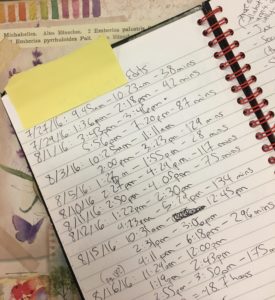 I’m taking the plunge! Starting in 2017, I will be writing fiction full-time. I’m taking the plunge! Starting in 2017, I will be writing fiction full-time.
I’m lucky to have the opportunity. It’s taken me years to find enough freelance gigs to make the budget work. And who knows? Maybe I won’t like being in charge of every aspect of my work life. There are certainly things I enjoy about my office day job. My coworkers, my bosses and mentors, the new and interesting challenges that crop up each day. It’s scary to leave that certainty behind in favor of the uncertain world of freelance.
So why did I decide to take the risk?
Because in the past year, as I’ve juggled my full-time day job alongside my freelance projects, I’ve realized: I don’t work from 9 to 5.
I go in to the office for those hours. But much of that time is spent attending meetings, responding to emails, working on daily maintenance tasks, taking tea breaks, snack breaks, more tea breaks, hunting for communal baked goods in the kitchenette… You get the picture.
By contrast, when I’m freelancing, my only billable hours are the ones I spend with my butt in the chair writing. I have to track those hours meticulously, and in doing so, I started to better understand how I actually work: in sprints.
When I first started recording, my work sprints usually lasted 15-20 minutes. Since I made a note every time I started and stopped writing, I was able to see how long my breaks in between sprints lasted, too. Often when I thought I just took 5 minutes to quickly respond to an email, I’d actually stepped away from my work for 30-40 minutes!
I was surprised how often I interrupted my writing flow. I was also surprised at how much time I wasted, since I like to think of myself as an efficient person.
Thankfully, the first step to changing something is recognizing it. Now that I was tracking my time, I had a baseline to improve upon and a KPI (key performance indicator – as you may have guessed, my day job was in marketing) to track in order to measure said improvement.
Three new habits improved my productivity the most:
- Recognizing this pattern. Yep, just knowing that I’d be writing down the timestamp when I started and when I stopped motivated me to stay on task longer.
- Pre-planning. Before I started the clock each time, I took 1 minute to jot down a couple sentences about what I was going to work on, be it a rough scene outline or notes on what I needed to edit in this chapter.
- Setting goals. For example, when drafting, I told myself I could have a break to make more tea and obsessively refresh my inbox once I wrote 2,000 new words.
Soon, I found myself working for 45-60 minute sprints, with only 5-10 minute breaks in between. By working in longer chunks, I was able to consolidate my workday, finish projects sooner, and have more free time afterwards. In the past, I’d sit at my home office for 8 hours, but only write for 3. Now I can knock out 3 hours of writing in 3.5 hours and give myself the rest of the day off.
Recognizing that gave me the final motivational push to jump into freelancing full-time. It isn’t easy, and this coming year will be a real test of my self-discipline. But I have a feeling I’m going to enjoy it!
|
Mailing List Follow along as I write and travel around the world.
|
 Coming to Mexico, I knew there would be delicious tacos aplenty. Those certainly didn’t disappoint. Every taco I’ve eaten has been tasty, from the ones sold in street carts outside our office to the ones you can buy from guys who ride around the city on bikes ringing a bell to let you know they have tacos (sadly, this is not where Taco Bell got its name, but I like to pretend).
Coming to Mexico, I knew there would be delicious tacos aplenty. Those certainly didn’t disappoint. Every taco I’ve eaten has been tasty, from the ones sold in street carts outside our office to the ones you can buy from guys who ride around the city on bikes ringing a bell to let you know they have tacos (sadly, this is not where Taco Bell got its name, but I like to pretend). right next to my apartment at Café el Asturiano, a hole-in-the-wall with a 70 peso ($3.50) breakfast menu that includes red or green chilaquiles (get the green), fresh fruit, fresh-squeezed juice, fresh-baked bread and a tea or coffee.
right next to my apartment at Café el Asturiano, a hole-in-the-wall with a 70 peso ($3.50) breakfast menu that includes red or green chilaquiles (get the green), fresh fruit, fresh-squeezed juice, fresh-baked bread and a tea or coffee.
 The Mexico City restaurant scene rivals New York’s, in my amateur-foodie opinion. There are fantastic seafood restaurants like Contramar; up-and-coming vegan delivery spots like Los Loosers, which changes its menu daily (it was mole ramen the day I went); and three of the top 50 restaurants in the world. A lot of the people I’m traveling with raved about Biko and Quintonil, two of those, but I only tried Pujol. It was a uniquely delicious experience, and I loved everything from the baby corn cooked in chicatana ant sauce to the mole madre (which had been cooking for 1,185 days when we went). The humorously-named Happy Ending was delicious too—a dessert course comprised of avocado ice cream, churros, coconut pastry, and some kind of chocolate-y beverage. If the other two top restaurants are anything like Pujol, holy crap, I need to come back to Mexico City ASAP and eat there too.
The Mexico City restaurant scene rivals New York’s, in my amateur-foodie opinion. There are fantastic seafood restaurants like Contramar; up-and-coming vegan delivery spots like Los Loosers, which changes its menu daily (it was mole ramen the day I went); and three of the top 50 restaurants in the world. A lot of the people I’m traveling with raved about Biko and Quintonil, two of those, but I only tried Pujol. It was a uniquely delicious experience, and I loved everything from the baby corn cooked in chicatana ant sauce to the mole madre (which had been cooking for 1,185 days when we went). The humorously-named Happy Ending was delicious too—a dessert course comprised of avocado ice cream, churros, coconut pastry, and some kind of chocolate-y beverage. If the other two top restaurants are anything like Pujol, holy crap, I need to come back to Mexico City ASAP and eat there too.






























 Trying to speak Spanish after 10 years without using it is a constant exercise in humility. One moment I’m having an in-depth conversation with a doctor about switching medications from my U.S. brand to a comparable Mexican one, and the next minute I’ve completely forgotten the word for fork.
Trying to speak Spanish after 10 years without using it is a constant exercise in humility. One moment I’m having an in-depth conversation with a doctor about switching medications from my U.S. brand to a comparable Mexican one, and the next minute I’ve completely forgotten the word for fork. It’s not that I don’t enjoy learning. I love reading books, going on historical tours, watching documentaries. But I’m bad at it, because I make everything about me. When a tour guide talks about local history, I usually latch on to the first interesting tidbit they mention, then drift off into daydreams—thinking about how I could use that factoid in a story, or how it intersects with other facts I’ve heard.
It’s not that I don’t enjoy learning. I love reading books, going on historical tours, watching documentaries. But I’m bad at it, because I make everything about me. When a tour guide talks about local history, I usually latch on to the first interesting tidbit they mention, then drift off into daydreams—thinking about how I could use that factoid in a story, or how it intersects with other facts I’ve heard. that place or go on that tour. Usually it’s even interesting (or at least, I think so).
that place or go on that tour. Usually it’s even interesting (or at least, I think so).
 Across the Bosque de Chapultepec (Chapultepec Park), I climbed up to
Across the Bosque de Chapultepec (Chapultepec Park), I climbed up to  Arena México and learned that hechicero means sorcerer. I met up with an old college friend and an internet friend who also works remote, whose schedule finally synced with mine (after 10 years of trying). I visited
Arena México and learned that hechicero means sorcerer. I met up with an old college friend and an internet friend who also works remote, whose schedule finally synced with mine (after 10 years of trying). I visited  Along with a few other Remotes, I watched the Chef’s Table episode about
Along with a few other Remotes, I watched the Chef’s Table episode about 




 I haven’t been at the freelance bit long (just over 2 weeks full-time), but I am already starting to notice things I’ll miss about working a regular 9-5 office job. Nothing earth-shattering, just little day-to-day amenities that I took for granted when they were right in front of me. Now that I’m out of the office and striking forth on my own, I’ve started to notice those little things.
I haven’t been at the freelance bit long (just over 2 weeks full-time), but I am already starting to notice things I’ll miss about working a regular 9-5 office job. Nothing earth-shattering, just little day-to-day amenities that I took for granted when they were right in front of me. Now that I’m out of the office and striking forth on my own, I’ve started to notice those little things. Weirdly, I’ve been waking up earlier than I used to for my office hours – I’m that excited to hop out of bed and start writing every day! All things considered, I made the right call going freelance. (At least, so I think after a few weeks. We’ll see how I’m feeling in a year!)
Weirdly, I’ve been waking up earlier than I used to for my office hours – I’m that excited to hop out of bed and start writing every day! All things considered, I made the right call going freelance. (At least, so I think after a few weeks. We’ll see how I’m feeling in a year!) I didn’t make a New Years Resolution so much as a life goal. Last year was
I didn’t make a New Years Resolution so much as a life goal. Last year was  Much like in Europe, table service is slow, unhurried. Nobody wants to rush you, and nobody is in a hurry themselves, either. The New Yorker in me got impatient at first – I have so much writing to do! So many neighborhoods to explore and museums to visit!
Much like in Europe, table service is slow, unhurried. Nobody wants to rush you, and nobody is in a hurry themselves, either. The New Yorker in me got impatient at first – I have so much writing to do! So many neighborhoods to explore and museums to visit! I wanted to see them all. But instead of trying to rush, I followed my instincts. I was craving greenery. Instead of museum-hopping, I settled near a stream, took off my shoes, and wrote freehand. Nothing for work, just notes for future stories. Random ideas. Snippets of memories from the week.
I wanted to see them all. But instead of trying to rush, I followed my instincts. I was craving greenery. Instead of museum-hopping, I settled near a stream, took off my shoes, and wrote freehand. Nothing for work, just notes for future stories. Random ideas. Snippets of memories from the week. is a must see, but not on the 12th of the month, her day, because it’s a madhouse). All throughout our conversation, he kept using the word relajado. To describe life in Mexico City, his job, relationships, people here on the whole.
is a must see, but not on the 12th of the month, her day, because it’s a madhouse). All throughout our conversation, he kept using the word relajado. To describe life in Mexico City, his job, relationships, people here on the whole.

 In my last post, I talked about my
In my last post, I talked about my  I’m taking the plunge! Starting in 2017, I will be writing fiction full-time.
I’m taking the plunge! Starting in 2017, I will be writing fiction full-time.